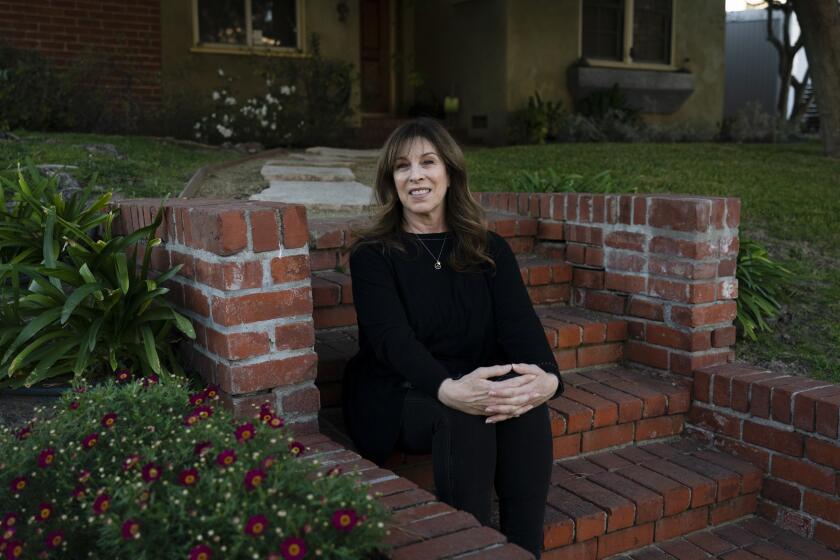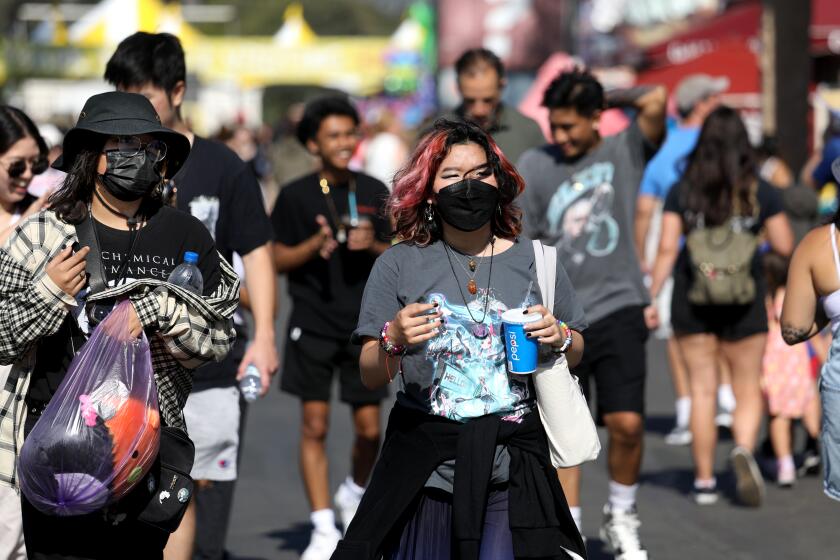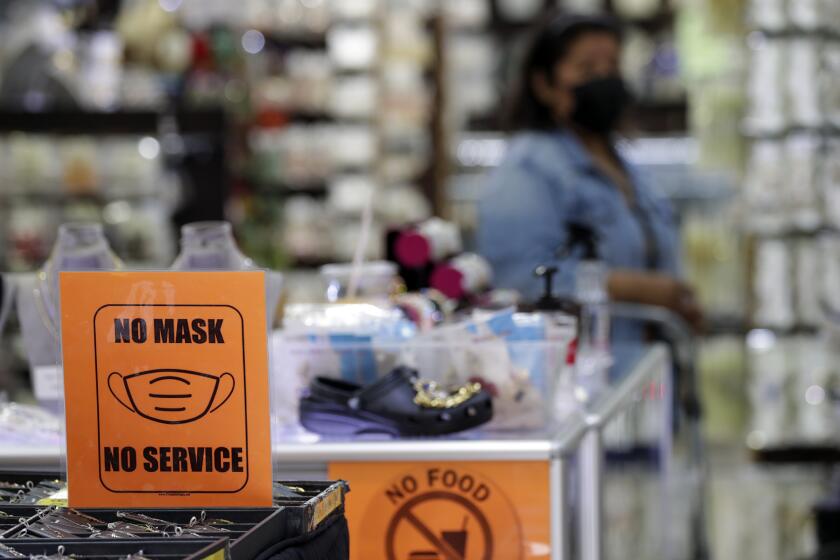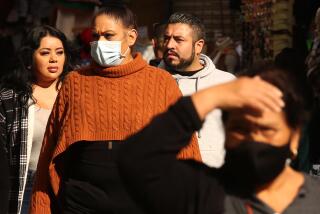L.A. County narrowly avoided a mask mandate. Can we keep BA.5 in check?
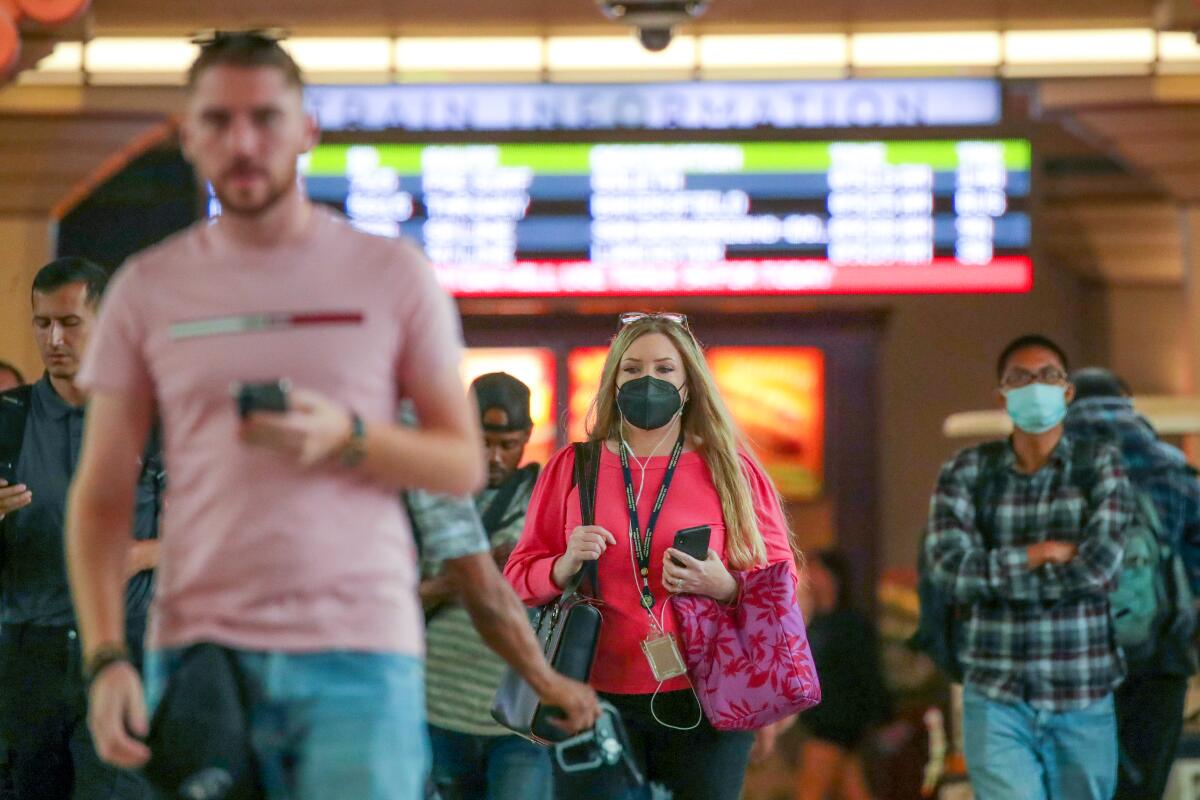
- Share via
Citing declining cases, Los Angeles County Public Health Director Barbara Ferrer announced Thursday her department would not impose a mask mandate to deal with a summer surge fueled by super-contagious Omicron subvariants such as BA.5.
But that does not mean L.A. County is out of the woods.
Despite recent improvements, L.A. County is still wrestling with an immense amount of coronavirus transmission. The latest case rate remains far above the peak of last summer’s Delta surge, and officials note the tally is likely a significant undercount due to the widespread use of at-home tests.
As unprecedented numbers of Omicron subvariants continue to fuel a new coronavirus wave, there is growing alarm about long COVID, in which symptoms or increased risk of illness can persist for months or even years.
Here is a look at where we are:
Mostly positive signs
In mid-July, L.A. County began moving rapidly toward new indoor mask rules. But last week, conditions began to improve.
- Cases: Coronavirus cases are now continuing to decline. As of Friday afternoon, L.A. County was averaging about 5,700 coronavirus cases a day over the past seven days, down 15% from the prior week. On a per-capita basis, the latest rate is 392 cases a week for every 100,000 residents. A case rate of 100 or more is considered high.
- New hospital admissions: Some hospitals in L.A. County noticed an increase in hospitalizations this month, but those numbers have since dipped. L.A. County on Thursday said there are 9.7 new weekly coronavirus-positive hospital admissions for every 100,000 residents. That’s a decline of 15% over the prior week.
- Hospital census: The number of coronavirus-positive patients in L.A. County’s hospitals on any given day has stabilized. L.A. County recorded its highest number of coronavirus-positive patients in the hospital since the winter on July 20, when there were 1,329. Since then, the number has stabilized, falling as low as 1,200 before settling at 1,239 Thursday.
- Workplaces and vulnerable areas: The weekly number of workplaces reporting clusters of coronavirus cases is 399, down from the prior week’s count of 429. Case rates in the poorest areas of the county fell by 5% over the past week.
- Transmission rate: The California COVID Assessment Tool, published by the state Department of Public Health, estimated that the effective transmission rate in L.A. County was 1.01 as of Sunday — indicating that the spread of COVID-19 is likely stable.
- Wastewater: While the viral concentration in wastewater at two of L.A. County’s largest sewage plants remained high, L.A. County Public Health Director Ferrer said progress was evident, with the facility for the southern and eastern parts of the county recording a decrease in the virus’ presence, and the one for the city of Los Angeles starting to plateau.
- Deaths: One disheartening, but expected, trend is that deaths are continuing to climb, a lagging effect of previous increases in cases and hospitalization. As of Friday, L.A. County was recording 106 COVID-19 deaths a week, a 9% week-over-week increase. A month ago, the tally was 57 deaths a week.
What is going on?
The decline in cases could be attributable to a number of factors.
As coronavirus cases have climbed in recent weeks, and hospitalizations have worsened, a number of businesses in L.A. County have tightened up on COVID-19 restrictions.
Many who become infected are not falling seriously ill. While hospitalizations are rising, patients are generally less sick, and intensive care units are less crowded than in previous surges.
About a month ago, hospitalization levels passed a threshold that triggered the TV and film industry in the L.A. area to resume certain indoor masking requirements.
Some organizations also decided to cancel or postpone gatherings or move them outside. In shifting its in-person summer tour to virtual sessions, the Television Critics Assn. cited growing concerns about the surge, fueled by the hyper-contagious BA.5 subvariant, and the potential for a new mask mandate in L.A. County as reasons why “shows in production cannot or do not want to break COVID bubbles” and “producers, writers, talent, and publicists are not willing to appear in person.”
Despite plans to reinstate a mask mandate in Los Angeles County, the value of widespread masking isn’t what it used to be.
It remains unclear whether BA.5 is starting to run out of people to infect, Ferrer said.
With the current prevalence of cases, in a group of 50 people, there’s a 60% to 70% likelihood that someone is infected, she said.
“I would strongly advise that everyone keep their masks on,” Ferrer said.
Health officials say it’s OK to live your life, but it’s smart to ramp up protections, such as masking, testing before events and having good ventilation.
What is next?
For now, indoor masks remain strongly encouraged but not mandatory in most places.
- Future assessment: L.A. County initially said if the region reached the high COVID-19 community level, as defined by the U.S. Centers for Disease Control and Prevention, and remained there for three consecutive Thursdays, a new mask order would be issued. It remains unclear whether health officials will continue to pursue a potential mask mandate should the county return to the high level. It’s not likely L.A. County will reenter that phase in the immediate future, Ferrer said, since case counts and hospitalizations are declining.
- BA.5: Future trends of the highly infectious subvariant are uncertain because of the volatility of the various Omicron subvariants. Nationally, for the week that ended July 23, BA.5 constituted 82% of estimated coronavirus cases. Two months earlier, it made up less than 3% of estimated cases.
- Transit: Masks remain required — as they have for months — in indoor public transit areas in L.A. County, including in taxis, Ubers and Lyfts and in airports, as well as in healthcare settings, nursing homes, jails, prisons, shelters and in settings where businesses or venues require it.
- Politics: The proposed indoor mask mandate was controversial, with many business groups and some politicians opposing it. There also has been some debate in scientific circles.
- Schools: The step back from masking means that the soon-to-start traditional school year is likely to be mask-optional, as it was in spring. The county announcement elicited a tweet of support from L.A. schools Supt. Alberto Carvalho. “The right decision at the right time, following the right science,” he tweeted.
More to Read
Sign up for Essential California
The most important California stories and recommendations in your inbox every morning.
You may occasionally receive promotional content from the Los Angeles Times.
